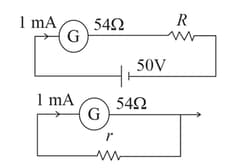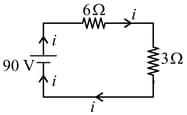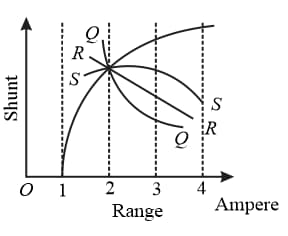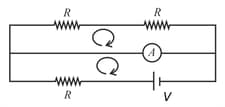Ammeter
Ammeter: Overview
This topic covers concepts, such as, Ammeter,Conversion of Galvanometer into an Ammeter,Shunting and Shunt Resistance etc.
Important Questions on Ammeter
A galvanometer has a resistance of . It gives full scale deflection with a current of 2 mA. Calculate the value of the resistance needed to convert it into an ammeter of range
Out of the two, an ammeter or a milliammeter, ammeter has a higher resistance.
How do you convert a galvanometer into an ammeter?
For designing a voltmeter of range and an ammeter of range using a galvanometer which has a coil of resistance showing a full scale deflection for as in figure.

(A) for voltmeter
(B) for ammeter
(C) for ammeter
(D) for voltmeter
(E) for voltmeter
Choose the correct answer from the options given below:
A galvanometer of resistance is shunted with . The effective resistance of the combination is . Then which of the following statements is true
Find the current in resistance. If an ammeter of resistance, is connected in parallel with than find its reading.

The deflection in galvanometer falls to , when it is shunted by . If additional shunt of is connected in parallel to earlier shunt, the deflection in galvanometer falls to value. Write the value of .
Two identical fuses are rated at
To convert a galvanometer into an ammeter, one should connect
The coil of a moving coil galvanometer has an effective area of It is suspended in a magnetic field of If the deflection in the galvanometer coil is when a current of is passed through it, then
A galvanometer of resistance gives a deflection of divisions per There are divisions on the scale. Maximum current that can pass through it when a shunt resistance of is connected is
A resistance is connected to a battery of . A galvanometer of resistance is to be used as an ammeter to measure current through the resistance, for this a resistance is connected to the galvanometer. Which of the following connections should be employed if the measured current is within of the current without the ammeter in the circuit?
A galvanometer has current sensitivity of divisions per milliampere with equal divisions. Find shunt resistance required to convert given galvanometer into an ammeter of range ?
A galvanometer has current sensitivity of divisions per with equal divisions. The shunt resistance in required to convert given galvanometer into an ammeter of range is . Write the value of to the nearest integer. Here, galvanometer voltage is .
If an ammeter is to be used in place of a voltmeter, then with the ammeter we must connect a,
The ammeter has range of , without shunt. The range can be varied by using different shunt resistances. The graph between shunt resistance and range will have the nature as

A moving coil galvanometer of resistance is used as an ammeter using a resistance . The maximum deflection current in the galvanometer is . Find the minimum current in the circuit so that the ammeter shows maximum deflection.
The resistance of an ammeter formed by converting a galvanometer will be:
A galvanometer having a resistance of is shunted by a wire of resistance If the total current is the part of it passing through the shunt will be

